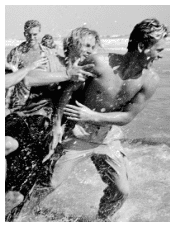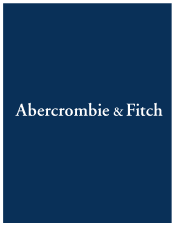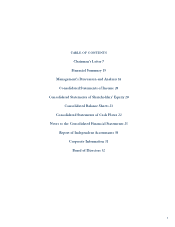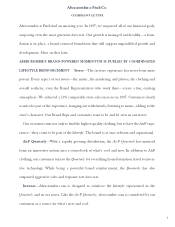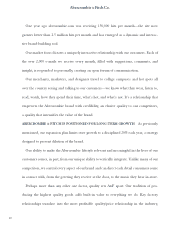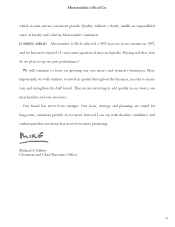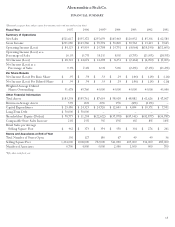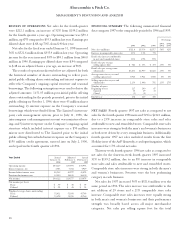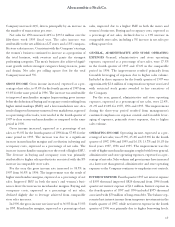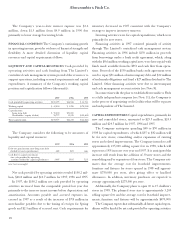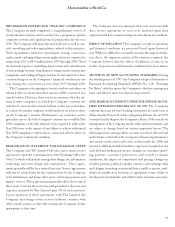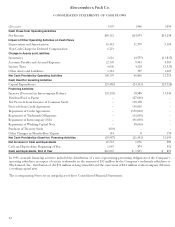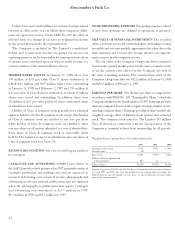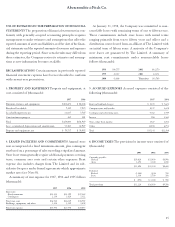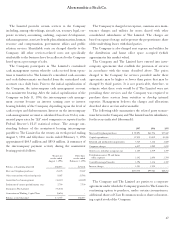Abercrombie & Fitch 1997 Annual Report Download - page 9
Download and view the complete annual report
Please find page 9 of the 1997 Abercrombie & Fitch annual report below. You can navigate through the pages in the report by either clicking on the pages listed below, or by using the keyword search tool below to find specific information within the annual report.
Company increased 24%, driven principally by an increase in
the number of transactions per store.
Net sales for 1996 increased 42% to $335.4 million over the
fifty-three week 1995 fiscal year. The sales increase was
attributable to the net addition of 27 stores and a 13% compara-
ble store sales increase. Consistent with the Company’s strategy,
the women’s business continued to increase as a proportion of
the total business, with sweaters and pants the strongest
performing categories. The men’s business also achieved signif-
icant growth with its strongest categories being sweaters, pants
and denim. Net sales per selling square foot for the total
Company increased 5%.
GROSS INCOME Gross income increased, expressed as a per-
centage of net sales, to 45.4% for the fourth quarter of 1997 from
43.0% for the same period in 1996. The increase was attributable
to improved merchandise margins (representing gross income
before the deduction of buying and occupancy costs) resulting from
higher initial markups (IMU) and a lower markdown rate. As a
result of improved inventory turnover, fewer markdowns, expressed
as a percentage of net sales, were needed in the fourth quarter of
1997 to clear season-end merchandise as compared to the same
period in 1996.
Gross income increased, expressed as a percentage of net
sales, to 43.0% for the fourth quarter of 1996 from 37.4% for the
same period in 1995. The increase was due to a significant
increase in merchandise margins and a reduction in buying and
occupancy costs, expressed as a percentage of net sales. The
increase in merchandise margins was the result of higher IMU.
The decrease in buying and occupancy costs was primarily
attributable to higher sales productivity associated with the 8%
increase in comparable store sales.
For the year, the gross income rate increased to 38.5% in
1997 from 36.9% in 1996. The improvement was the result of
higher merchandise margins, expressed as a percentage of net
sales. Improved IMU in both the men’s and women’s busi-
nesses drove the increase in merchandise margins. Buying and
occupancy costs, expressed as a percentage of net sales,
declined slightly due to leverage achieved from comparable
store sales increases.
In 1996, the gross income rate increased to 36.9% from 33.9%
in 1995. Merchandise margins, expressed as a percentage of net
17
Abercrombie &Fitch Co.
sales, improved due to a higher IMU in both the men’s and
women’s businesses. Buying and occupancy costs, expressed as
a percentage of net sales, declined due to a 13% increase in
comparable store sales, including a 5% increase in net sales per
selling square foot.
GENERAL, ADMINISTRATIVE AND STORE OPERATING
EXPENSES General, administrative and store operating
expenses, expressed as a percentage of net sales, were 17.5%
in the fourth quarter of 1997 and 17.6% in the comparable
period in 1996. The improvement resulted primarily from
favorable leveraging of expenses due to higher sales volume.
Included in these expenses for the fourth quarter of 1997 was
approximately $2.6 million of compensation expense associated
with restricted stock grants awarded to key executives of
the Company.
For the year, general, administrative and store operating
expenses, expressed as a percentage of net sales, were 22.4%,
23.2% and 23.8% for 1997, 1996 and 1995. The improvement
during the three-year period resulted from management’s
continued emphasis on expense control and favorable lever-
aging of expenses, primarily stores expenses, due to higher
sales volume.
OPERATING INCOME Operating income, expressed as a per-
centage of net sales, was 27.9%, 25.4% and 19.8% for the fourth
quarter of 1997, 1996 and 1995 and 16.1%, 13.7% and 10.1% for
fiscal years 1997, 1996 and 1995. The improvement was the
result of higher merchandise margins coupled with lower general,
administrative and store operating expenses, expressed as a per-
centage of net sales. Sales volume and gross income have increased
at a faster rate than general, administrative and store operating
expenses as the Company continues to emphasize cost controls.
INTEREST EXPENSE Fourth quarter 1997 net interest expense
of $305 thousand improved $820 thousand from 1996 fourth
quarter net interest expense of $1.1 million. Interest expense in
the fourth quarter of 1997 and 1996 included $975 thousand
associated with $50 million of long-term debt. The balance rep-
resented net interest income from temporary investments in the
fourth quarter of 1997, while net interest expense in the fourth
quarter of 1996 was primarily due to higher borrowing levels.

